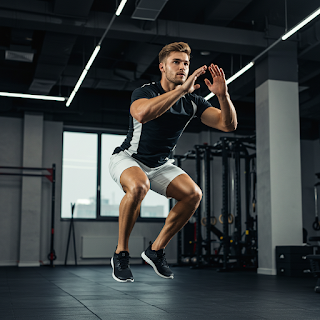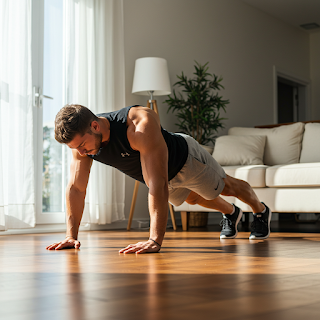Exercise Hacks: Short Workouts That Boost Longevity
For those looking to boost their longevity while keeping up with a busy schedule, the key is making exercise efficient, effective, and sustainable. In this post, we’ll explore how short workouts, when done correctly, can enhance your health, improve your fitness, and add years to your life. We'll dive into the science behind these "exercise hacks" and offer practical strategies you can implement today.
The Science Behind Short Workouts and Longevity
When it comes to exercise and longevity, quality often trumps quantity. While prolonged endurance training and daily hour-long sessions certainly have their benefits, research increasingly supports the idea that short, intense, or strategically timed workouts can be just as effective for improving health.
A major study published in the Journal of the American Heart Association found that even small bursts of moderate-to-vigorous physical activity, as short as 5 to 10 minutes, can lower the risk of death from heart disease, stroke, and other causes. Another study in The Lancet demonstrated that just 15 minutes of physical activity per day can extend lifespan by up to three years. These findings suggest that you don’t need to commit to long workouts to achieve significant health benefits—short, consistent efforts can have a profound impact.
Why do short workouts work so well? The answer lies in their intensity and the cumulative effect of frequent movement. Brief periods of high-intensity exercise can stimulate cardiovascular health, improve metabolic function, and enhance muscle strength, all of which contribute to a longer, healthier life. Furthermore, short workouts are easier to maintain over time, helping you stay consistent, which is arguably the most important factor for long-term health and fitness.
The Longevity Benefits of Short Workouts
Short workouts don’t just save you time—they can also offer unique benefits that support longevity. Let’s take a closer look at how these brief sessions contribute to a longer, healthier life.
1. Improved Cardiovascular Health
One of the most significant benefits of regular exercise is its impact on cardiovascular health. Short, intense bursts of activity, such as high-intensity interval training (HIIT), have been shown to improve heart health, reduce blood pressure, and increase circulation. These improvements reduce the risk of heart disease, the leading cause of death worldwide.
A 2016 study published in the Journal of the American College of Cardiology found that just 5 to 10 minutes of moderate exercise each day, like jogging or brisk walking, can significantly lower the risk of cardiovascular disease. Additionally, HIIT, which alternates short bursts of intense activity with periods of rest or lower intensity, is particularly effective for improving heart health in a shorter amount of time than traditional endurance training.
2. Increased Muscle Mass and Strength
As we age, maintaining muscle mass and strength becomes increasingly important for overall health and longevity. Sarcopenia, the age-related loss of muscle mass, can lead to frailty, reduced mobility, and an increased risk of falls. Resistance training, even when done in short sessions, helps to combat muscle loss and maintain functional strength.
A study published in The American Journal of Physiology highlighted that short but intense resistance training sessions can stimulate muscle growth and improve strength. Compound exercises, like squats, lunges, and push-ups, target multiple muscle groups simultaneously, making them ideal for time-efficient workouts that build strength and endurance.
3. Enhanced Metabolic Health
Short workouts, especially those involving high-intensity activity, can significantly improve metabolic health. HIIT, for example, has been shown to boost insulin sensitivity, improve glucose metabolism, and promote fat loss, all of which are critical factors in preventing chronic conditions like type 2 diabetes and obesity.
A study published in Diabetologia found that just three 10-minute sessions of HIIT per week could improve insulin sensitivity by 24%, helping to prevent the onset of metabolic diseases. This suggests that even minimal amounts of exercise can profoundly impact your metabolic health, contributing to a longer, healthier life.
4. Reduced Inflammation and Oxidative Stress
Chronic inflammation and oxidative stress are major contributors to aging and age-related diseases, including cancer, Alzheimer’s disease, and heart disease. Exercise, even in short bursts, has been shown to reduce inflammation and improve the body’s antioxidant defense system.
A 2018 study in Frontiers in Physiology found that regular physical activity, regardless of duration, helps regulate inflammatory markers and reduce oxidative damage in cells. This means that even short workouts can play a role in slowing down the aging process and reducing the risk of chronic diseases.
5. Improved Mental Health and Cognitive Function
Exercise isn’t just beneficial for your body—it also supports brain health and mental well-being. Physical activity stimulates the release of endorphins, which help reduce stress, anxiety, and depression. Moreover, short bouts of exercise have been shown to improve focus, memory, and overall cognitive function, which are crucial for maintaining mental sharpness as we age.
In a study published in The British Journal of Sports Medicine, researchers found that even 10 minutes of moderate-intensity exercise can improve attention, working memory, and problem-solving skills. Additionally, regular short workouts may reduce the risk of cognitive decline and dementia, enhancing both the quality and length of life.
Effective Short Workouts to Boost Longevity
Now that we’ve explored the science behind short workouts, let’s dive into some practical examples you can incorporate into your daily routine. These workouts are designed to be quick, effective, and adaptable to any fitness level. You can do them at home, in the office, or even outdoors, making them easy to fit into a busy schedule.
1. High-Intensity Interval Training (HIIT)
HIIT is one of the most efficient ways to exercise if you’re short on time. A typical HIIT workout lasts anywhere from 10 to 20 minutes and alternates between short periods of intense effort (like sprinting or burpees) and recovery periods (like walking or resting).
Example HIIT Routine (10 Minutes):
- 30 seconds of jumping jacks
- 30 seconds of push-ups
- 30 seconds of squats
- 30 seconds of mountain climbers
- Repeat the circuit 3 times, resting for 30 seconds between each circuit.
This simple routine can be done in just 10 minutes but offers significant benefits for cardiovascular fitness, fat loss, and muscle strength.
2. Tabata Training
Tabata is a form of HIIT that involves 20 seconds of maximum effort followed by 10 seconds of rest, repeated for 4 minutes. This quick and intense workout is perfect for people who are pressed for time but still want to experience the benefits of high-intensity training.
Example Tabata Routine (4 Minutes):
- 20 seconds of burpees
- 10 seconds rest
- 20 seconds of squats
- 10 seconds rest
- Repeat for 4 minutes.
While Tabata is brief, it can dramatically improve cardiovascular health and metabolic function in just a few minutes.
3. Bodyweight Circuit Training
Bodyweight exercises are ideal for short workouts because they don’t require any equipment and can be done anywhere. By combining multiple exercises that target different muscle groups, you can get a full-body workout in under 20 minutes.
Example Bodyweight Circuit (15 Minutes):
- 20 squats
- 15 push-ups
- 20 lunges (10 per leg)
- 30-second plank
- 15 triceps dips (use a chair or bench)
- Repeat the circuit 3 times with minimal rest between exercises.
This routine will work your major muscle groups and elevate your heart rate, giving you a total-body workout in just 15 minutes.
4. The 7-Minute Workout
The 7-minute workout, popularized by researchers from the Human Performance Institute, is designed to provide maximum benefits in minimal time. It consists of 12 bodyweight exercises performed for 30 seconds each, with a 10-second rest between exercises.
Example 7-Minute Workout:
- Jumping jacks
- Wall sit
- Push-ups
- Abdominal crunches
- Step-ups onto a chair
- Squats
- Triceps dips on a chair
- Plank
- High knees/running in place
- Lunges
- Push-up with rotation
- Side plank
This workout is quick but effective, targeting all the major muscle groups while providing a cardiovascular challenge.
5. Micro Workouts Throughout the Day
If you can’t dedicate a block of time to exercise, consider breaking your workout into smaller "micro workouts" spread throughout the day. Research shows that frequent, short bursts of activity can be just as beneficial as one longer session.
Example Micro Workout Plan:
- 2 minutes of squats while waiting for your coffee in the morning.
- 5-minute brisk walk during your lunch break.
- 10 push-ups and 10 squats before dinner.
- 1-minute plank before bed.
These micro workouts may seem small, but they add up over time, keeping your body active and your metabolism engaged throughout the day.
How to Stay Consistent with Short Workouts
One of the greatest advantages of short workouts is that they’re easier to stick with, making consistency more achievable. Here are some tips to help you stay on track:
- Schedule Your Workouts: Treat short workouts like important appointments. Set a specific time each day to fit in your exercise, even if it’s just 10 minutes.
- Use Reminders: Set alarms on your phone or use a fitness tracker to remind you to take breaks for exercise throughout the day.
- Stay Flexible: Short workouts give you the flexibility to adapt to your schedule. If you miss a morning session, fit in a few minutes of movement during your lunch break or in the evening.
- Track Your Progress: Keep a journal or use an app to track your workouts and progress. Seeing improvements in strength, endurance, or overall fitness will motivate you to keep going.
Conclusion: Short Workouts for a Long, Healthy Life
Exercise doesn’t have to be a time-consuming or daunting task. Short, efficient workouts can offer substantial health benefits, helping you live longer, stay fit, and feel energized throughout the day. By incorporating brief periods of physical activity into your routine—whether through HIIT, bodyweight exercises, or micro workouts—you can dramatically improve your cardiovascular health, strength, and mental well-being.
The key to longevity isn’t necessarily found in lengthy, grueling exercise sessions but in maintaining a consistent, sustainable routine that fits into your lifestyle. Even with just a few minutes a day, you can unlock the powerful benefits of exercise, enhance your quality of life, and add years to your journey. So lace up your sneakers, grab a mat, and get moving—your future self will thank you.






Comments
Post a Comment